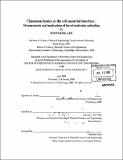Chemomechanics at the cell-material interface : measurements and implications of forced molecular unbinding
Author(s)
Lee, Sunyoung, Ph. D. Massachusetts Institute of Technology
DownloadFull printable version (53.54Mb)
Alternative title
Measurements and implications of forced molecular unbinding
Other Contributors
Massachusetts Institute of Technology. Dept. of Materials Science and Engineering.
Advisor
Krystyn J. Van Vliet.
Terms of use
Metadata
Show full item recordAbstract
The main goal of this thesis is to study the coupled interactions between chemically and mechanically characterized materials and cells that are relevant to microvascular physiology and pathology. In particular, the mechanical characterization of cell surface structure and force generation are realized via various atomic force microscopy (AFM) imaging techniques including AFM cell force spectroscopy and functionalized force imaging. In these approaches, the recognition of mechanical responses of cells or mapping of cell surface receptors is mediated by chemomechanically characterized AFM cantilevers. The high spatial and force resolution of AFM imaging techniques and force spectroscopy enabled investigation of mechanical interaction at the cell-cell or cell-material interfaces. This interaction was studied via the mapping of specific receptors on endothelial cell surfaces and the detection of pN-scale force transmission through ligand-receptor pairs on the plasma membrane with biophysical interpretation of cellular force generation. This thesis consists of four major chapters: the recognition of vascular endothelial growth factor receptors and of anti-angiogenic oligopeptide receptors on endothelial cell surfaces, mechanical interaction between endothelial cells and pericytes that encompass capillary blood vessels; cell-matrix contact via focal complexes; and leukemia cells rolling on endothelial cell surfaces and P-selectin-conjugated glass substrata. (cont.) This thesis also includes appendices that detail the effect of force transducer stiffness on the measurement of unbinding force, nerve cell imaging to I observe the connection between axons and dendrites, and chemomechanical characterization of polyelectrolyte multilayers, biodegradable hydrogels, and biological glues. In Chapter 2, transmembrane receptors on endothelial cell surfaces are mapped and associated binding kinetics/thermodynamics of ligand-receptor pairs are quantified via AFM functionalized force imaging or single-molecule recognition imaging. Functionalized force imaging is then used to identify unknown receptors, receptors for an oligopeptide isolated from tissue inhibitor of metalloproteinase-2, called Loop 6. In Chapter 3, mechanical stress by pericytes that envelop capillary blood vessels is quantified, demonstrating that pericytes exert significant mechanical strain on the extracellular environment. In Chapter 4, picoNewton-scale force dynamics at fibroblasts' focal complexes, measured in real-time through cell force spectroscopy, demonstrates that cells exert mechanical force that can speed the rupture of ligand-receptor pairs in focal complexes during migration and adhesion to underlying substrata. The last part of this thesis, Chapter 5, discusses the role of actin-mediated force in leukemia cell rolling on endothelial cell surfaces. The measurement of picoNewton-scale force dynamics using cell force spectroscopy suggests that, in addition to drag force exerted by blood flow, cytoskeletal force dynamics contribute to the cell rolling process. (cont.) Together, these studies from the single-molecule to whole-cell level detail the strong coupling between mechanical force and ligand-receptor reaction kinetics.
Description
Thesis (Ph. D.)--Massachusetts Institute of Technology, Dept. of Materials Science and Engineering, 2009. Cataloged from PDF version of thesis. Includes bibliographical references.
Date issued
2009Department
Massachusetts Institute of Technology. Department of Materials Science and EngineeringPublisher
Massachusetts Institute of Technology
Keywords
Materials Science and Engineering.